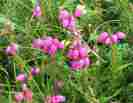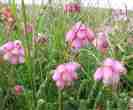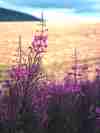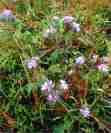|
Wild Flowers in Late Summer Late Summer in Caithness By late July the vegetation is becoming mature and plants are concentrating on seed production rather than growth. There are some plants, however, that can ripen seeds quickly and continue to prosper when they flower late. And some, of course, reproduce by spreading vegetatively and do not have to rely on seed. In particular, there are several yellow-flowered Composites that show themselves in late summer - that is - plants with flowers like daisies and dandelions in flower structure. Along the roadside verges the Autumn Hawkbit (Leontodon autumnalis) lines the roadside with a yellow carpet some six inches high. It seems to like the salty environment created by winter salt spreading. Along roadsides and seashores the tall yellow-flowered Perennial Sow-thistle (Sonchus arvensis) stands three feet high with strong prickles on its leaves. It is the harbinger of autumn for me! And there is a strong show of yellow from Common Ragwort (Senecio jacobaea). which is poisonous to most animals and a serious pest in the countryside. Another harbinger of autumn is the Rosebay Willowherb (Chamerion angustifolium) which forms dense colonies here and there adding a mass of pinkish purple colour to the landscape. In the wet meadow the Meadowsweet (Filipendula ulmaria) dominates to the exclusion of many other plants. Three of the Caithness lochs have around their margins fairly sweet, muddy wet ground which is the home of the nationally rare Narrow Small-reed (Calamagrostis stricta). And the margins of another loch has the total world population of the Scottish Small-reed (Calamagrostis scotica) which is quite unique to this one loch in Caithness. These two grasses flower in August. On the peaty moorlands the Heather (Calluna vulgaris) comes into flower in early August to colour the hills and moors with purple. In drier parts of the moor the Bell Heather (Erica cinerea) shows a bigger flower of a more intense purple and in the wetter parts the Cross-leaved Heath (Erica tetralix) shows flowers of a paler pinky purple. All three species can show white flowers - white heather is a genetic strain which is not uncommon (I would expect to meet it at least once in a day's walk over the autumnal moors). As the summer fades the iron in the leaves of the moorland plants shows up as a red colouration and the moorland turns a wine-red colour. A late-flowering species that has appeared this year for the first time in cornfields and set-aside land is the blue flowered Phacelia (Phacelia tanacetifolia). It is an annual plant introduced from California with seed mixtures. It will be interesting to see if it persists by setting seed. Autumn Hawkbit (Leontodon autumnalis) 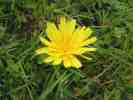 is a
yellow composite flower (generally like a dandelion), a rosette of
leaves at the base, but a solid flower stem (dandelions are hollow). It
flowers in late summer and is common in rough grassland and roadside
verges. It is the flower that lines the roadside verges with yellow in
August, being about 6 inches high. is a
yellow composite flower (generally like a dandelion), a rosette of
leaves at the base, but a solid flower stem (dandelions are hollow). It
flowers in late summer and is common in rough grassland and roadside
verges. It is the flower that lines the roadside verges with yellow in
August, being about 6 inches high.
Perennial Sow-thistle (Sonchus arvensis)
Common Ragwort (Senecio jacobaea)
Meadowsweet (Filipendula ulmaria)
Heather (Calluna vulgaris)
Bell Heather (Erica cinerea)
Cross-leaved Heather (Erica tetralix)
Rosebay Willowherb (Chamerion angustifolium)
Scottish Small-reed (Calamagrostis scotica)
Narrow Small-reed (Calamagrostis stricta)
Phacelia (Phacelia tanacetifolia)
|
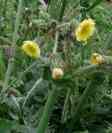
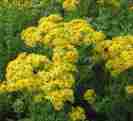
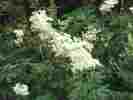
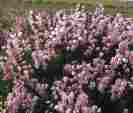 is the plant
that dominates large areas of the drier peatmoors of Caithness. It is a
dwarf shrub that flowers during August, its pinky-purple flowers
colouring the moors and hills. It has small single leaves (3 mm long) of
triangular section. White flowered heather is occasionally found.
Heather cannot tolerate long periods of inundation or drying out, so it
keeps to the medium-dry part of the moor, being replaced by Cross-leaved
Heath in the wetter places and by Bell Heather in the dryer places. It
may be attacked by Heather Beetle which can kill out large areas, and it
is often set back or killed by burning as part of moorland management.
Despite that it could claim to be the most common plant in Caithness.
is the plant
that dominates large areas of the drier peatmoors of Caithness. It is a
dwarf shrub that flowers during August, its pinky-purple flowers
colouring the moors and hills. It has small single leaves (3 mm long) of
triangular section. White flowered heather is occasionally found.
Heather cannot tolerate long periods of inundation or drying out, so it
keeps to the medium-dry part of the moor, being replaced by Cross-leaved
Heath in the wetter places and by Bell Heather in the dryer places. It
may be attacked by Heather Beetle which can kill out large areas, and it
is often set back or killed by burning as part of moorland management.
Despite that it could claim to be the most common plant in Caithness.